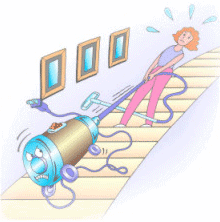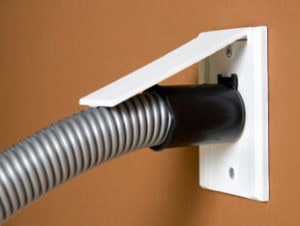Vacuuming is one of those jobs that no one likes to do. While it doesn’t rank with bathroom cleaning as a least favorite chore, it’s a job that is physically demanding. If you have several levels in your home, that also means lugging a heavy vacuum up and down stairs and from room to room. Think about incorporating a central vacuum system to your plans.
With a central vacuum system, your workload has just gotten lighter. You’ll still need to clean as often, but since you merely carry a hose from room to room, you’ll be far more likely to tackle the job or get the kids to pitch in.
How A Central Vacuum System Works
A central vacuum system is basically a power unit that draws dirt and debris through piping in the walls to a central refuse storage container. There are inlets positioned along baseboards or on walls to which a portable hose and power brush are attached. This lightweight length of hosing and brush attachment is all the homeowner needs to vacuum every room in the house.
The debris winds up in a container or bag that only needs to be cleaned out or replaced every few months. Both the container and the power unit are situated in a remote location that’s away from the family living quarters.
There are also automatic dust pan inlets available for your kitchen, bathroom and mudroom. Simply tap a lever with your foot, and sweep dirt and debris into the slot. It connects to the power unit through the same tubing as the other inlets, and your dirt is sucked into the storage container.
Planning For Your Central Vacuum System

Locate the central power unit in an unobtrusive area of your home. This is typically the basement, garage or utility room. Tubing is run through the walls and floors of the house. Inlet valves are positioned in various locations along baseboards or on walls.
Since many timber frame homes have an open floor plan, it’s important to plan where you will position your tubing and inlets to ensure there are inlets available to reach all areas of your home.
Choosing Your Central Vacuum System
There are two styles of vacuum systems. They are filtered and cyclonic vacuum systems. Depending on the manufacturer, a filtered unit uses a screen, foam, paper or cloth device to clean and filter the air taken in by the vacuum. Naturally, these need to be cleaned or replaced. A cyclonic system uses centrifugal force and gravity to capture and separate the dirt and debris from the vacuumed air. In both systems the dirt is deposited into a storage canister or bag.
In selecting your central vacuum system, you need to consider the square footage of your home to determine the amount of power you’ll need. You also need to decide whether you want a bag unit that requires replacing a debris bag or a debris storage canister that needs to be emptied.
The power brush is what you are using to vacuum your house and it may be either electric or air driven. Since they don’t need electricity wired to each inlet, air driven systems are less costly to install.
Benefits Of A Central Vacuum System
Technology and consumer desire for “the best that money can buy” has driven up the price of many standard vacuums. This narrows the gap between the cost of a central vacuum system and a portable vacuum. This increasingly smaller gap makes a central vacuum system a realistic and cost-effective answer to house cleaning.
Central vacuums can have up to five times more power than a portable vacuum. Since they are stationary, the system has a far more powerful motor.

Dirty air is not recirculated in the room, keeping dust and contaminants at a minimum.
In general, central vacuum systems create less noise than portable vacuums. The motor is isolated from living spaces, so any noise is confined to the utility room, basement or garage.
Central vacuum systems offer the same variety of attachments and accessories found with standard vacuums.
If one day you decide to sell, this permanent addition may increase the resale value of your home, or at least be an attractive feature that entices buyers.
While planning your new timber frame home, you’ll come across countless ideas you would love to include in the design or décor. A central vacuum system may not be the most glamorous or sexy addition to your home plan, but it may be one of the most practical ideas for making your home easier to clean and enjoy.
